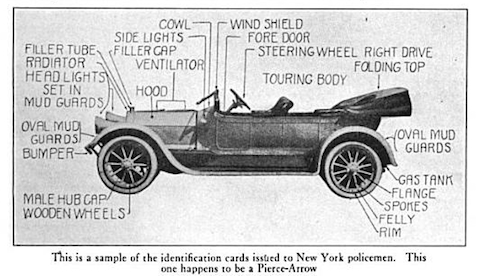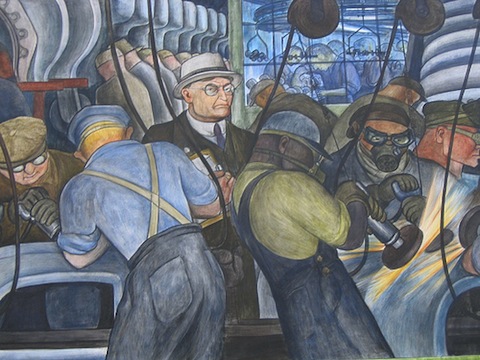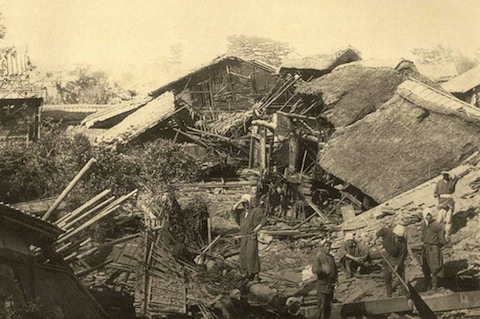Heading off to West Texas for a Wired reporting trip today, so light posting for the next lil’ while. Until I manage to secure myself some dependable WiFi in the lightly populated triangle between Lubbock, Abilene, and Wichita Falls, please make do with highlights of the late-period Fly Girls. Sad to think such joyously athletic choreography has now vanished from the small screen, yet the depressing vapidity of Dancing With the Stars flourishes.
Lone Star
March 29th, 2011
“One of the Greatest Evils of the Age”
March 28th, 2011

I’m a huge believer in the notion that the good ol’ days were not quite as halcyon as they’re cracked up to be. That anti-nostalgia truism becomes especially clear when one examines crime data from bygone eras; Americans, it turns out, have been treating one another quite unkindly for generations. I made that point in a post last September regarding Jacksonville’s once-astronomical homicide rate, which far exceeded that of Chicago at its early 1970s worst. Now I have another piece of evidence, in the form of automobile theft rates from Wilson Administration.
Take the case of Detroit, for example, which had a 1920 population roughly equivalent to what the decaying city claims today. There were roughly 3,360 automobile thefts in the Motor City in 1920, versus a tick over 13,000 in 2009. But you also have to factor in car ownership rates; only 3 percent of Americans owned autos in 1920. It is thus reasonable to surmise that a significant percentage of car owners back then had to suffer through at least one theft per year, despite the advent of various gadgets designed to frustrate thieves.
I initially thought that the majority of these bygone thefts were the work of joy-riders, who simply wanted to experience the magic of the internal combustion engine. But this account from Omaha’s chief of police offers a different take:
I have found among the auto thieves who have been arrested here, many old time “Yegg” men, who have given up the blowing of safes and robbing of country stores and taken to the stealing of automobiles, as they figure they take less chances and make more money in the game when they have a “fence” in some other city who will handle stolen cars for them.
Then there are a lot of crooked chauffeurs, who, when they want to leave the city, generally figure on taking an auto with them. They usually find a sale for the car, as there is always someone in every city trying to buy something for half its value.
Not helping matters from a law-enforcement standpoint: the fact that there were just a handful of body styles, and thus no easy way to identify stolen vehicles.
Auto theft did decline precipitously during the 1920s, in part because of technological innovations, but also due to greater cooperation between police departments. It’s easy to forget that America used to be far more provincial; the regional differences we notice today pale in comparison to the real animosity that formerly existed between states and cities. I wonder how much of that was due to the federal government muscling in on cases in which stolen goods were transported across state lines; if Hollywood has taught me anything, it’s that city cops loathe nothing more than getting usurped by the Feds.
Comments Off on “One of the Greatest Evils of the Age”Tags:1920s·auto theft·crime·Detroit
The Art of Catching Lampreys
March 25th, 2011

Following up on an earlier post about the decline of England’s enthusiasm for eels, I spent (wasted?) a fair bit of time this morning digging into America’s long-standing hatred for lampreys. These parasitic fish, widely held responsible for the death of King Henry I, were once on the verge of conquering the Great Lakes; they were essentially the Asian carp of their day, inspiring conservationists to dream up all manner of zany schemes to stop their invasion. We eventually stopped the lamprey from becoming too great a nuisance with the invention of TMF, an effective lampricide that has been dumped into the Great Lakes since 1958.
I did wonder, however, whether there were any serious efforts to convince the American public that lampreys were a delicacy on par with cod or halibut. They were enjoyed not only by English kings, but also by generations of Maori, who called the fish piharau and used ingenious means to ensnare them. Perhaps all the lampreys needed was better PR—or, perhaps, a pact between the U.S. government and Long John Silver’s to develop a tasty breading-and-frying method.
By the way, yes, I realize that I cheated with the image above—lampreys are not eels. I just wanted a nice excuse to point your toward this fantastic trove of materials related to Maori eeling techniques and technologies. I found the eel spears to be particularly impressive.
→ 4 CommentsTags:Asian carp·eels·environment·fish·fishing·food·Great Lakes·invasive species·lampreys·New Zealand
Messing with the Bull
March 24th, 2011

I have mixed feelings about Ross Dunkley, the Australian who co-founded the Myanmar Times in 2000. It’s impossible not to admire his moxie; rare is the publishing soul brave enough to open a new information venture in a totalitarian state. But Dunkley obviously had to make some bargains to earn that opportunity, and that meant partnering with some rather unsavory characters—men with strong ties to Burma’s sinister ruling junta, who demanded a 51 percent stake in Dunkley’s media company. When one of his first partners ended up in prison after a 2005 political purge, Dunkley kept chugging along with the replacement offered up by the generals: Tin Tun Oo, a wealthy operative from the government’s information ministry. I have no doubt that such ties have occasionally affected the way in which the Times reports news.
But now Dunkley is learning just how easily he, too, can be squeezed out of the picture, thanks to Burma’s utter lack of transparent due process:
At the fifth hearing in the case against the Australian founder of the Myanmar Times, Ross Dunkley, a Burmese court on Wednesday again denied him bail and set a sixth hearing for Tuesday, March 29…
Dunkley has been charged with violating the Immigration Act, assaulting a woman, giving her drugs and holding her against her will. He was arrested on February 10 and taken to Insein Prison the next day. Dunkley’s business associates said in an earlier statement that the alleged female victim testified in a previous hearing that she wished to withdraw her complaint that alleged she had been drugged by Dunkley but the Burmese authorities would not allow the complaint to be withdrawn…
Rangoon media observers said that Dunkley and the Myanmar Times’ new CEO, Dr. Tin Tun Oo, were involved in a business dispute at the time of his arrest. Tin Tun Oo was named the new CEO four days after Dunkley’s arrest.
Perhaps Dunkely is, indeed, guilty of the charges levied against him. But my gut tells me otherwise; it instead whispers that this is all a part of the junta’s growing campaign to clamp down even tighter on the nation’s information flow—a campaign that has also included a ban on Skype and other VoIP services. The generals have no intention of getting ambushed by technology, like their dictatorial brethren in the Middle East.
Comments Off on Messing with the BullTags:Burma·business·dictatorship·journalism·law·Ross Dunkley
Are You Reeling in the Years?
March 23rd, 2011
 Those commendable souls who frequent this space may have noticed Microkhan’s recent obsession with Papua New Guinea. This is by accident more than design, I assure you; the endlessly fascinating linchpin of Oceania simply has a lot going on these days, to the point that it has become a topic of much conversation in America’s halls of power.
Those commendable souls who frequent this space may have noticed Microkhan’s recent obsession with Papua New Guinea. This is by accident more than design, I assure you; the endlessly fascinating linchpin of Oceania simply has a lot going on these days, to the point that it has become a topic of much conversation in America’s halls of power.
Expect Papua New Guinea’s name to become ever-more prominent in Western circles, due to the possibility that the long-shuttered Panguna copper mine on the island of Bougainville may finally be reopening. One of the richest mines in the world in terms of reserves, Panguna closed down 22 years ago, amidst a supremely violent conflict between a Bougainville liberation movement and the PNG government. Now that conflict has simmered down, and key power players on the island seem willing to make peace in exchange for a cut of the mine’s future revenues. Needless to say, both the U.S. and China are keenly interested in this development, as they battle each other to be first in line for the world’s mineral wealth.
But Panguna’s reopening is no foregone conclusion, as there are remnants of Bougainville’s insurgency who are unlikely to get on board with whatever plan emerges. Chief among these is Noah Musingku, who calls himself King David Peii II and clams to rule a royal kingdom on Bougainville. Though commonly dismissed as a con artist, Musingku strikes me as something more irrational—a man who, though certainly interested in bilking investors out of money, earnestly believes he can reinvent Bougainville as some sort of utopia. Exhibit A in this lunacy is his ongoing effort to get Bougainville to ditch the Grigorian calendar in favor of one of his own design. As he explained in a speech last year:
Let me summarize my short speech by giving a brief explanation of the new U-Vistract calendar system. Many of you still do not seem to understand our calendar system although we are already in the midst of its third phase. The names for the 12 months were taken directly from the Book of Revelations Chapter 21. There are 12 foundational stones of the New Jerusalem City. The first month is Jasper, second is Sapphire, third is Agate, fourth is Emerald, fifth is Onyx, sixth is Carnellian, seventh is Quartz, eighth is Beryl, ninth is Topaz, tenth is Chalcedony, eleventh is Turquoise, and twelfth is Amethyst.
The first day (Lightday) falls on Wednesday of the conventional calendar. Second day (Skyday) falls on Thursday; third day (Plantsday) falls on Friday; fourth day (Solarday) falls on Saturday; fifth day (falls on Sunday; sixth day falls on Monday; seventh day (Restday) falls on Tuesday…
The UV calendar starts in the month of Jasper (July). Here in Siwai district where the UV system originated/is headquartered, the word ‘year’ is called ‘Moi‘ in our local tongue. Eg. If you are 30 years of age you are said to have ’30 Moi ‘. This year is 2010 AD. In the Siwai /Motuna language we would say “this Moi is 2010 AD”. The word for Moi is derived from the Siwai word for “Galip Nut” tree which bears fruit every year in June/July depicting a new year. A year or Moi in Siwai/Bougainville therefore, begins in the month of July (Jasper) and ends in the month of Amethyst (June).
You can download the whole calendar here, if you’re so inclined. Suffice to say, rulers who have attempted to make arbitrary changes to the calendar have not fared particularly well over the long haul. I’m thinking of the folks behind the French Republican Calendar and, more recently, the revolting Turkmenbashi. A wise man accepts that certain innovations have lasted for a reason, even if said innovations were created by a detested “other.” Plus the small psychological benefits of showing the world your mastery over time surely pale in comparison to the drawbacks of being out of temporal sync with every source of capital on the planet.
In any event, have a nice Lightday today, which I believe falls in the month of Chalcedony.
(Image via Ilya Gridneff)
→ 5 CommentsTags:Bougainville·dictatorship·French Revolution·Noah Musingku·Papua New Guinea·Turkmenbashi
Scrolls and Combinations
March 22nd, 2011
Apologies, but squeezed for time today—have to bolt early to record a segment for Here & Now, as well as arrange a trip out to East Texas for next week. A classic above to tide you over, as you surely count the minutes ’til tomorrow’s post about the new Great Game and the madness it’s inspiring.
A Pocketful of Eels
March 21st, 2011

Modern slang is full of gastronomical synonyms for money: dough, bread, cabbage, cake. Notably absent from the long list, however, is a foodstuff that once actually functioned as a form of currency: the humble eel, a traditional English delicacy often served in jellied form. Nine centuries ago or thereabouts, eels were more than just a form of sustenance for the inhabitants of post-Norman Conquest England; they were a way for vassals to pay their lords. The authors of 1906’s The History and Law of Fisheries explain:
Eels at this period were considered the choice fish, and throughout Domesday Book we continually find this rent of eels as rent of fisheries, e.g. Evreham (Bucks), “De iiij piscariis 1,500 eels et pisces per diem veneris ad opus prepositi ville“; Medmenham (Bucks), “De piscar mille anguillas,” and in this county the rent or value of all the seventeen fisheries is returned in eels. The case is the same in Cambrideshire. In Hertfordshire all the rents or values of fisheries are in eels…In Kent we find rents in eels and rents in money for fisheries…In Northamtonshire there is no mention of any fishery, but many returns of mills valued and money and eel rents.
English waterways no longer teems with eels, of course, an environmental mystery that greatly upsets conservationists. But it is not scarcity that seems to have diminished the eel’s central position in the English diet (not to mention English economics); there are plenty of farmed eels to be imported from Southeast Asia, and the the eels that are harvested domestically are mostly exported to the European continent. The eel’s value to England declined because tastes changed, so that the slithery fish is now considered somewhat revolting by the nation’s majority.
Why, then, do food habits—and even food taboos—change so drastically over the centuries? It’s no secret that our affinity for certain foods over others doesn’t have much grounding in logic. But we do drift toward foods that we regard as commensurate with our inflated image of ourselves. Eels were the mainstay of England during some truly rough times; once prosperity arrived with the dawn of the Industrial Revolution, people no longer wanted to eat what had sustained their less fortunate forbears. Beefsteaks were the right food for the growing bourgeoisie, and so the flesh of cows became the nation’s go-to dish.
One must wonder, though, whether the staple meats of today will someday be looked back upon in the same manner that most English now regard the eel. Will hamburgers be reduced to carnival fare, much like jellied eels in Brighton?
(Image via sallysue)
→ 8 CommentsTags:currency·economics·eels·England·fish·food·Medieval history
Made in America
March 18th, 2011

I somehow went almost an entire month without pimping my latest Wired feature, which appears in the March issue (alongside Joel Johnson‘s excellent cover story on the Foxconn suicides). The piece is a deeply reported essay that tackles a tricky business proposition: For companies that make products out of atoms, does manufacturing in China and other low-cost countries still make sense?
The answer depends on where your firm exists in the economic food chain. As I make clear in the story, I have no expectation that that iPad 3 will be made in the U.S.A.; Apple and other titans of industry have the muscle to make Chinese outsourcing work in their favor. But the equation is a lot muddier for smaller companies—”the innovative guts of America’s technology industry,” as I term them in the piece. Though American manufacturers still can’t compete on price alone, the math is evening out to the point that smart companies are carefully weighing the pros and cons of staying home. And the biggest pro, of course, is the ability to control quality:
“If you’re a huge company like Apple, you can get the whole factory to work for you,” says Paul King, founder of Hercules Networks, a New York company that makes charging kiosks for mobile devices. “You can put your own process in place, you can have your own quality control. But without that kind of power, you’re just another customer, and they don’t really care.” King cycled through three Chinese factories from 2008 to 2010 before giving up on offshoring due to persistent manufacturing errors—LCDs that winked out after six months, lights that broke when tapped even gently. The quality woes have disappeared now that Hercules is making its kiosks in the US, King says, and the company is thriving.
To deal with their production backlogs, many Chinese factories have started subcontracting work to facilities located in the center and western areas of the country, where labor costs are cheaper than on the industrialized coasts. But this usually makes the problems even worse. “They’ll subcontract your work without providing the subcontractor with the same training that you provided to them,” says George T. Haley, a professor of industrial and international marketing at the University of New Haven who specializes in Chinese business. “Then all of a sudden, your quality assurance goes all to hell.”
On a personal note, this piece grew out of some of the Grand Empress’s experiences manufacturing lingerie abroad. I’ve seen firsthand how production delays and quality flaws can set back a young business, often at the worst possible time. As it turns out, Wired editor-in-chief Chris Anderson was on the same wavelength; his side company, 3D Robotics, now manufactures in the U.S., and couldn’t be happier with its decision. We both felt there was a story here, and plenty of lessons to be learned for American start-ups.
If you have even the vaguest interest in the business realm, I hope you’ll check out the piece and offer some feedback in comments. Unlike the typical Microkhan fare, there is no mention of Papua New Guinea, livestock management, or pyramid schemes. But that’s not necessarily a bad thing.
(Image of Diego Rivera’s River Rouge Mural via dfb)
→ 9 CommentsTags:business·China·economics·manufacturing·Wired
Hocus Pocus, Cont’d
March 17th, 2011

I’ve previously written about the continued existence of anti-sorcery laws in the Vanuatuan penal code, so I felt compelled to post about the current debate in Papua New Guinea over similar statutes. The PNG government has grown increasingly alarmed over a rash of murders linked to beliefs in witchcraft:
In Papua New Guinea (PNG), the law on sorcery and sorcery related killings is being reviewed in an attempt to either repeal the Sorcery Act or make amendments to the Act by Parliament to make it more enforceable, and to help courts of law deal appropriately with such cases.
This is because sorcery and its related killings have escalated recently, and needs to be addressed as part of the law and order problems in the country.
Yesterday, Joe Mek Teine, Chairman of the Constitutional and Law Reform Commission (CLRC) which is tasked to collect information to create laws, described sorcery and sorcery related killings as a “dreaded disease” that needs to addressed, contained and regulated because it is eating into the fabrics of society.
Mr. Teine is also the Member for Kundiawa/Gembogl in the Chimbu Province, where this issue is part of their lives, and where, according to him, people have now lost the respect of the rule of law.
There are some fascinating aspects of legal philosophy that come into play here. Sorcery by itself is bunk, of course—you’ll never convince me that its practitioners actually possess any supernatural powers. But it’s clear that significant portions of PNG’s population believe in the practice, to the point that they regard the murder of suspected witches as a form of self-defense. To reduce the number of slayings, then, the government may need to toughen penalties against what is, in effect, an imaginary pursuit.
I actually doubt that constitutional change, even if backed up by strict enforcement, can eliminate centuries’ worth of folk tradition. The only real cure for this irrational ailment is the introduction of knowledge, and that must be a genuine grassroots effort.
(Image via David Wall)
Hydrofoil Engaged
March 16th, 2011
If I don’t get some serious writing done on my behind-schedule Wired feature today, I fear that all will be lost. Wish me luck, and brace for tomorrow’s post about gambling in the highlands of Papua New Guinea.
Comments Off on Hydrofoil EngagedTags:games·Pole Position·TV
The Exclusion Zone
March 15th, 2011
Having grown up in fear of nuclear catastrophe, the post-earthquake turmoil at the Fukushima reactors has really knocked me for a loop. From the moment the plants’ administrators started issuing mealy-mouthed explanations about the situation, I knew that disaster was imminent. The big question now is not only how much radiation will blow toward Japan’s major population centers, but what will become of the area around the plants. Land is an incredibly precious resource in Japan, given its relatively tiny size and large population. Let’s assume that, whether by official edict or mere consumer prefer, a terrestrial semi-circle behind the plant becomes devoid of inhabitants for several years. Let’s also assume that the radius of this semi-circle is 30 kilometers, equivalent to that of the “exclusion zone” around Chernobyl. That comes out to around 1,413 square miles, or roughly 1 percent of Japan’s total land mass. (No, I’m not controlling for national parks, inland lakes, and other variables—go with it.) In the American terms, the equivalent would be roping off a piece of property the size of Delaware and Rhode Island combined (plus a few hundred miles more).
It’s heady stuff to contend with, but I’ve found some comfort by thumbing through Haruki Murakami’s Underground, one of my all-time favorite works of non-fiction. An oral history of the Tokyo gas attacks of 1995, Underground provides a slew of tiny moments that attest to the Japanese public’s ability to cope with the unthinkable. I’ve previously written about the subway attendant who took time to fix his tie and hair despite suffering the ill effects of sarin; now I’d like to turn your attention to the recollections of an accountant whose daily ritual once consisted of buying milk in Shinjuku. Nothing, it seems, could keep him from that appointed task on the day of the attacks:
It was around Yotsuya Station I first felt sick. My nose ran all of a sudden. I thought I’d caught a cold, because I started to feel empty-headed, too, and everything before my eyes grew dark, like I had sunglasses on.
At the time, I was scared it was some kind of brain hemorrhage. I’d never experienced anything like it before, so I naturally thought the worst. This wasn’t just a cold; it was a lot more serious. I felt as though I might keel over any minute.
I don’t remember much about the others in the car. I was too concerned about myself. Anyway, somehow I made it to Shinjuku-gyoemmae and got off. I was dizzy; everything was black. “I’m done for,” I thought. Walking was a terrific struggle. I had to grope my way up the steps to the exit. Outside it might as well have been nighttime. I was in pain, yet I still bought my milk as usual. Strange, isn’t it? I went into the AM/PM store and bought some milk. It didn’t even occur to me not to. Thinking back on it now, it’s a mystery to me why I’d buy milk like that when I was in such agony.
Actually, I sort of get it. Routines serve an important function—they’re evidence that all is normal. And when things go awry, you try to stick to that routine to convince yourself that the chaos around you is an illusion, that you’re still in control. Such a strategy has little chance of working on an individual level—this poor accountant collapsed soon after purchasing his milk. But if an entire population commits to continuing to go through the motions of daily life, however difficult, virtually any catastrophe can be overcome.
→ 8 CommentsTags:books·earthquake·Fukushima·Haruki Murakami·Japan·nuclear power·Underground
The Ultimate Tribute
March 14th, 2011
I just split my morning between two fruitless tasks: the first an investigation of pending nuclear projects in the developing world, the second an attempt to understand naming conventions in the world of cattle breeding. My curiosity about the latter issue was piqued by news of a bull auction in North Platte, Nebraska, where bovines with such tongue-twisting names as SLGN Copperlass Tiara 7101T X SLGN Stockman 632S will soon change hands. I feel like there must be some method to the naming madness, but I don’t have nearly enough time to put in the proper research. Perhaps later in the week…
I did, however, run across this nifty breakdown of Estonian cow names. Good to see that our dairy-farming friends in the Baltics have a sense of humor about their herds:
In all, 7,161 cow names are listed. The uninspiring but solid “Mustik”, which translates roughly as “black cow”, comes out on top, accounting for well over half the total. Other popular choices include common Estonian female names, such as Ursula, Piret and Kadri.
Other monikers exhibit the “unique” Estonian brand of humour. Some 205 cows go by “Keku”, meaning someone who is vain. Thirty-five are named “Mammut” (mammoth). Whether by accident or by design, Estonian celebrities are also accounted for. The name “Kiku” appears 438 times on the list. Besides being a slang word for baby teeth, it’s also the nickname of Olympic skiing star Kristiina Shmigun.
I will not rest until a cow or bull bears the name Microkhan. That is truly the only real metric for success for these days.
→ 6 CommentsTags:agriculture·cows·Estonia·Fabulous Souls·music·R&B
Degrees of Fragility
March 11th, 2011

I was all set to end the week with a post about a particularly egregious patent-medicine fraud, but it somehow seems wrong in light of the catastrophe in Japan. We often forget how much our species is at the mercy of the planet, and how quickly everything we treasure can be snatched away. For the moment, I can only take small comfort in the fact that my Japanese friends appear to be present and accounted for.
The silver lining here, though, is that the death toll in Japan would have been much, much worse had the nation not committed long ago to sound engineering. As previously discussed on Microkhan, it is disturbingly easy to predict an earthquake’s death toll based on both the magnitude of the tremor and, more important, the quality of the building stock. Scarred by several 19th-century earthquakes that decimated its population, Japan started taking earthquake safety seriously once it attained the requisite level of prosperity to enforce building codes. There is no way to calculate how many thousands of lives were saved today by the bureaucracy ensures that constructions firms don’t cut corners, and that private builders are appropriately punished for using sub-standard materials or ill-conceived designs.
One point to reiterate from my earlier earthquake post: A Nobel Prize certainly awaits the man or woman who can come up with a low-cost building material capable of mimicking timber’s strength. Japan is prosperous enough to afford materials that can bend and sway when rocked by the Earth; less fortunate nations are stuck with concrete, which is the last thing you want your house to be made of when a mega-tremor strikes.
(Photo from The Great Earthquake of Japan, 1891, via Baxley Stamps)
Update One of today’s great hero’s passed away 41 years ago: Tachu Naito, the father of Japanese earthquake-proof architecture. Great summary of his contributions here:
The 1923 Kanto Earthquake caused the establishment of the first seismic regulations in a building code in the world to affect a concentration of large engineered structures—the 1924 Building Code Enforcement Regulations. Building code regulations had been passed after the 1908 earthquake in Italy and in earlier Italian earthquakes, but the 1924 legislation is historic for its application to Tokyo and other intensively developed urban areas that had large structures. The seismic ratio (“shindo”) method in that code, using a 10% force level, was based on the work of Toshikata Sano of the University of Tokyo and his student, Tachu Naito (1886-1970), who became the head of structural engineering at Waseda University. Prior to that 1924 mandatory code, Naito had incorporated such thinking and carried out the necessary seismic calculations and detailing in his design of several large structures that performed well in 1923, such as the Kabuki Theater and Industrial Bank of Japan.
This was a historic first in earthquake engineering: A structural engineer employed seismic analysis computations, carefully designed the structure to resist those seismic loads, detailed the construction to implement new construction practices, and then saw the resulting building tested by a major earthquake. Naito’s buildings performed very well in contrast to the standard non-seismic designs of an American firm doing work in Tokyo at the same time, the George Fuller Company. They also did well as compared to the significantly damaged Imperial Hotel of Frank Lloyd Wright (1867-1959). (Reitherman, 1980) Wright’s admittedly brilliant architectural skills, as well as his knack for self- promotion, gave him a reputation as a heroic seismic designer in the popular press, but the engineering world was impressed by Naito.
Per the faith-based encyclopedia, Naito’s “Eureka!” moment occurred after he observed shifting luggage in an accelerating train. Wish I could get more backstory on that revelation, but my Japanese skills are basically zilch.
Comments Off on Degrees of FragilityTags:earthquakes·engineering·Japan·natural disasters
Lost in Translation
March 10th, 2011
Though English may be gaining an ever-greater toehold in the rest of the world, the United States appears to becoming increasingly polyglot. At the same time, first-generation immigrants are making landfall in far-flung locations throughout the U.S., rather than concentrating in a handful of urban centers. Those two trends spell trouble for courts with slim linguistic resources, not to mention non-English-speaking parties who must navigate the justice system.
We must thus expect more situations such as the recent case of Weston Ludrick, a native of Pohnpei who found himself accused of vehicular homicide in Arkansas. Ludrick’s primary tongue is Kiti, and he requested a translator who could assist in his defense. The court provided him with a woman who was a certified translator of Marshallese, but appeared to have only a rudimentary familiarity with Kiti. Ludrick used this fact as grounds for appeal:
Mr. Ludrick contends that he was forced to sit in total incomprehension as the trial went on around him. He asserts that his interpreter, Mrs. Joel, had never been an interpreter of Kiti nor had she interpreted in a jury trial. Moreover, Mr. Ludrick points out that on one occasion during the proceedings he gave an indication that he did not understand Mrs. Joel’s explanation of the proceedings, and he questions whether Mrs. Joel was interpreting the proceedings word for word as opposed to merely providing summaries or explanations. Mr. Ludrick further asserts that prior to the September 21, 2009, hearing, he was scheduled for a forensic evaluation but refused to speak to the psychiatrist because, as explained through Mrs. Joel, Mr. Ludrick did not think she could interpret well for him because she was born on the Marshall Islands. Finally, Mr. Ludrick contends that subsequent to that hearing Ms. Simmons reconsidered Mrs. Joel’s qualifications and believed she was no longer qualified to be a non-certified interpreter. Mr. Ludrick maintains that under these circumstances, the accuracy and scope of the translation during the proceedings were subject to grave doubt and that his due process rights were violated. Due to the trial court’s error in failing to make available a qualified and certified interpreter, Mr. Ludrick requests a new trial.
Ludrick lost his appeal because an Arkansas appeals court found that sufficiently diligent efforts had been made to locate a certified translator of Kiti, to no avail. But might this be a situation in which affordable technology could have come to the rescue? Granted, it’s going to be hard to find speakers of obscure languages in certain corners of the country where immigrant communities are small. But there is scant effort required these days to set up a video link to a distant locale; it seems Ludrick would have been better off communicating with a competent translator via Skype than being baffled by his court-appointed intermediary.
→ 2 CommentsTags:Arkansas·crime·Kiti·law·linguistics·Marshall Islands·Micronesia·Pohnpei·technology
The Garry Trudeau of Papua New Guinea
March 9th, 2011

Sad news out of Port Moresby, as cartoonist Bob Browne has passed on well before his time:
He was the creator of Mr Grass Roots, perhaps Papua New Guinea’s most loved comic character, which the magazine Islands Business once called “the social conscience of PNG”…
Roots became the Papua New Guinean Everyman, the knock-about character with a heart of gold, a belly full of beer and a thick skull where his long-suffering wife, Agnes, berated his foolishness with her famous “sospen”.
Through Roots – who started as a character called Lu promoting Isuzu trucks – Browne was able to reflect on PNG life through an eerily indigenous perspective and criticise its shortcomings in a gentle but incisive way.
The great strength of cartooning is the ability to take pot-shots at the gross, the venal, the dishonest, the lazy or the plain foolish from behind the protective ramparts of humour. Browne seldom let this advantage descend into bitterness or cruelty, thanks mainly to Grass Roots himself, a man both naive and aware, a hale and hearty innocent wandering through a confused and confusing world. In Australia, Roots would be called “a good bloke”, in the US “a good ol’ boy”, someone you felt drawn to protect even though you’d also harbour the suspicion he was in some mysterious way already ahead of you.
Browne’s work was collected in several volumes available Stateside. Don’t be frightened by the use of pidgin—the political edge shines through regardless. Samples here and here.
→ 2 CommentsTags:Bob Browne·books·comics·Grass Roots·Papua New Guinea
The Curtain Drops
March 8th, 2011

Though I frequent Broadway shows about as often as I indulge in White Castle—that is, once in a blue moon—I’ll admit to taking undue pleasures in the travails of Spider-Man: Turn Off the Dark. Not in the various serious injuries that the production has incurred, mind you, but rather in seeing what happens when unchecked egos are permitted access to endless gobs of money. There is something to be said for the usefulness of limits.
Yet I find myself disagreeing with pundits who’ve already declared Spider-Man the greatest flop in the history of musical theater. Assuming that things don’t pan out for the show, that contention might hold water in terms of the sheer amount of money lost. But as I understand it, the only folks who stand to suffer from Spider-Man‘s demise are people who won’t exactly be relegated to eating Top Ramen as a result. The same cannot be said for the money behind the 1993 mega-flop Leonardo da Vinci: A Portrait of Love, which washed off the London stage in a matter of weeks. That doomed production was backed by a shady operator named Duke Minks, who obtained his $4 million-plus investment from the Nauru Phosphate Royalties Trust, one of the first sovereign wealth funds in the world. The trust was charged with investing the hundreds of millions of dollars that Nauru earned from the harvesting of its bird guano; unfortunately for the island republic’s 10,000 or residents, those at the controls did an incredibly lousy job of picking projects to bet on:
Unscrupulous foreigners have played a large part in Nauru’s post-independence catastrophe. A series of shysters and con-artists persuaded Nauruans to fritter away their money. One Australian financial adviser persuaded Nauru to shell out £2m for a musical he had written about the life of Leonardo da Vinci, which folded after four weeks on the London stage. Another conned the government into spending $60m on “prime banknotes”, a sort of derivative that turned out to be just as dodgy as it sounds. Much of the money was eventually recovered, but only after lengthy court cases spanning several continents.
Nauruans, too, wasted their fair share. Many investments were made for reasons other than economic merit. The island, whose remoteness in the middle of the Pacific is impossible to exaggerate, makes an improbable air-travel hub. Yet the government backed Air Nauru, which for a while boasted a fleet of five 737s. (It is now down to one.) It did not help that former presidents used to commandeer the airline’s planes for holidays, leaving paying customers stranded on the tarmac. Similarly, a cruise ship based in Nauru did more for the people who worked on it than for the country’s bottom line. Prime pieces of property have languished, undeveloped, for decades. The government of Fiji recently repossessed a hotel in its capital that Nauru had bought years ago and then left to rot. Another hotel, in the Marshall Islands, has been under construction for more than 20 years. Over A$50m (US$36.6m) was spent on a site in Melbourne that Nauru later sold for less than A$20m.
By the time Nauru was on the financial brink, it was too late—the island’s phosphorous production had dropped to all-time lows (see above), with little chance of meaningful recovery over the long term. What should have been the most prosperous nation in the South Pacific has since been reduced to hosting an Australian detention center in order to make ends meet.
The Leonardo musical obviously played a relatively tiny part in the Nauru’s financial woes. But alarm bells should have sounded when that investment went sour. At the very least, it betrayed terrible judgment on the part of those accountable for doling out the trust’s funds. But when you have something on the order of $800 million in the bank account, seven-figure mistakes are too easy to ignore.
→ 3 CommentsTags:Duke Minks·economics·Leonardo da Vinci·mining·Nauru·phosphate·theater
Architectural Antipsychotics
March 7th, 2011

I’d wager that there isn’t a single state in the nation that lacks an architectural oddity dubbed something like “The Strangest House in the World.” You know what I’m talking about—that random tourist attraction that lies somewhere between two medium-sized towns, and is a testament to mankind’s ability to develop total (and somewhat frightening) tunnel vision when a project captures the imagination.
My personal favorite has long been Wisconsin’s House on the Rock, which grew out of a frustrated architect’s desire to one-up Frank Lloyd Wright. But it sounds as if I would have been an even greater sucker for New Jersey’s aptly named Palace of Depression, built during the Great Depression by George Daynor, a man who could charitably be described as being one can short of a six-pack. Daynor maintained a psychologically even keel during the Palace’s early years, as the challenge of building and maintaining the place acted as a sort of Colzapine. But he lost the plot during the 1950s, and his desperate attempt to maintain the Palace’s fame led to his bizarre downfall:
In 1956, Daynor gave the FBI a false tip as it was pursuing the kidnappers of a lost four-year-old boy. He said the suspects had recently been to the palace; his bald lie garnered him a year behind bars. By his own reckoning Daynor was 98 years old when he was sprung in 1958. Too feeble to keep up the palace, he wandered about Vineland wearing rouge on his cheeks and bobby pins in his hair. Even before his death in 1964 his home was slowly disintegrating.
From a psychological perspective, I’m interested in how dedication to specific tasks can help counter the symptoms of mental illness. I’m currently working on a major project that involves a similar situation—a person who dealt with multiple serious mental disorders by losing himself in intricate planning. I reckon that there is probably a pretty simple neuroscientific explanation for this—perhaps one can quiet rebellious parts of the mind by making sure that all the neurons are firing elsewhere.
→ 2 CommentsTags:architecture·mental illness·neuroscience·Palace of Depression·psychology
The Devil Collects
March 4th, 2011
Whenever I find myself running behind on a major project, my thoughts turn to a certain passage from Easy Riders, Raging Bulls that discusses Michael Cimino’s utter disdain for logistical constraints. When infamous director started shooting Heaven’s Gate in the spring of 1979, he did so with orders to stay within a $10 million budget (c. $29.2 million today) and to wrap up principal photography in 10 weeks. But once Cimino was out by his lonesome in Montana, that plan went all to smithereens:
Cimino’s perfectionism knew no bounds, and it soon became clear that he was shooting at an exceedingly slow pace. While the budget visualized two script pages a day of a 133-page script, the actual rate was closer to five-eighths of a page. After the first twelve days, he was ten days and fifteen pages behind. He started losing ground at the rate of one a day for every day shot. He was building, tearing down, and rebuilding sets, as well as piling on extras by the cartload. Cimino was shooting ten, twenty, thirty takes of every shot and printing almost every one, ten thousand of feet of film a day (two hours plus of film), which cost $200,000 per day or about $1 million a week. By June 1, a month and a half into the shoot, Cimino had reached the $10 million mark, equal to the original budget. But there were still 108 pages to go.
Whether the finished product deserves mention in Microkhan’s Bad Movie Friday series is up for debate; there are some killer visuals in the movie, but the pacing is weirdly lethargic and the constant speechifying is absolutely annoying. One thing we can all agree on, though, is that Heaven’s Gate elicited one of the all-time greatest slams in the history of film criticism, from The New York Times‘ Vincent Canby:
”Heaven’s Gate,” which opens today at the Cinema One, fails so completely that you might suspect Mr. Cimino sold his soul to the Devil to obtain the success of ”The Deer Hunter,” and the Devil has just come around to collect.
The grandeur of vision of the Vietnam film has turned pretentious. The feeling for character has vanished and Mr. Cimino’s approach to his subject is so predictable that watching the film is like a forced, four-hour walking tour of one’s own living room.
Is Cimino at peace with his historic cinematic disaster and the fact that it basically turned his name to mud in Hollywood? Read this 2002 Vanity Fair profile and decide for yourself. The man claims to be at peace with his life, but there’s definitely a deep sadness burbling beneath his radically altered appearance.
Comments Off on The Devil CollectsTags:Bad Movie Friday·Heaven's Gate·Michael Cimino·movies
Quicksilver’s Last Stand
March 3rd, 2011

News of the mercury thermometer’s imminent demise got me wondering about where, exactly, our quicksilver comes from these days. Much to my surprise, I discovered that there is but a single mine in the world dedicated solely to the production of mercury. It is in Khaidarkan, a village in southwestern Kyrgyzstan, where the poor soil has made profitable agriculture a near impossibility. So despite the obvious threat to the local environment, the mine carries on much as it has since the early 1940s, when it was founded to replace Ukrainian mines that had fallen into Nazi hands.
Khaidarkan remains a lone holdout despite powerful international pressure to shutter the operation. Or, to put things more accurately, powerful international pressure from governments and environmentalists. Businesses, on the other hand, remain quite pleased about Kyrgyzstan’s lone-wolf status as a primary mercury producer. This Norwegian report (PDF) explains why:
So why is Khaidarkan the only one still mining mercury for the global market? The main reason is the economic challenges facing Kyrgyzstan, particularly the region where the mine is located. The company that
manages the complex has been struggling with fluctuating mercury prices and continuous technical difficulties such as low ore grades and flooding of shafts with underground water. Many times the state-owned company has had to request subsidies and state support for continuing its operations and the initial efforts to privatize the mine did not yield results. Due to a lack of international regulations and control, Khaidarkan primary mercury is still in demand on the international market which contributes to the continuation of mining operations.
The bottom line is that, when it’s functioning at peak efficiency, the Khaidarkan mine can produce mercury much more cheaply than operations where mercury is culled as a byproduct of other processes. And so businesses that require mercury for their products keep on going back to Kyrgyzstan.
The Norwegian report goes on to recommend that international money go toward retraining the inhabitants of Khaidarkan to perform other jobs (such as gold mining and handicraft production). But has anyone considered outright bribery? It is very difficult to tell a lifelong miner that he must abandon his profession at a relatively advanced age and learn a new trade. Lump sums of cash may be much more enticing for the locals, rather than funneling the aid through middlemen who might not have the local population’s best interest at heart.
The whole Norwegian report is worth a read, if only for the spooky abandoned ferris wheel on page fourteen.
→ 5 CommentsTags:economics·environment·Kyrgyzstan·Mercury·mining
Behold the Pyramids
March 2nd, 2011
Something went terribly awry this morning when Microkhan Jr. dismounted from a shoulder ride; my glasses snapped in half as his size eights kicked against my nose, and I now find myself staring through crooked, taped-together frames that make me feel as if I’m wandering through a funhouse. I have a late-morning appointment to get a fresh pair, plus (gulp) my first-ever pair of contacts, so I gotta be brief here. But let me direct you to a slab or reportage that very much demands your attention: Dan Morrison’s multi-part Slate series on “The Bernie Madoff of Sudan.” I had no idea that Darfur had been victimized by a epic Ponzi scheme, one that ended up bilking roughly 50,000 people out of their meager life savings. Morrison (occasionally known around these part as “our man in Dhaka”) got one victim to summarize the depressingly familiar particulars of the scheme:
The pyramid scheme began in early 2009 when Ismael, then a police officer who sold used cars on the side, opened an investment fund in Rahma Souk, or Mercy Market, not far from the state police headquarters in El Fasher, the capital of North Darfur state. The fund promised alarming returns. Investors would make in-kind payments of real estate or vehicles and receive, four to six weeks later, a check with a value of 150 percent of their initial investment.
To riff off of H.L. Mencken, no one ever went broke by underestimating a public’s zeal to get rich quick. The Albanians can certainly confirm that bit of folk wisdom.
→ 5 CommentsTags:Albania·crime·Dan Morrison·Darfur·Slate·Sudan
Charlie Don’t Surrender
March 1st, 2011

Over the past day or so, I’ve once again been flooded with mail regarding my Alcoholics Anonymous opus from last July’s Wired. The reason, of course, is Charlie Sheen’s recent decision to come out hard against the organization, which he accuses of being (and I paraphrase) a fraudulent mind-control cult with an abysmal success rate. Skeptics have rejoiced over adding such a high-profile figure to their ranks, while 12-step devotees have bemoaned the damage that Sheen’s rants might do to addicts who require help. Epistles from members of both cliques have shown up in my inbox recently—some to mock, others to plead for help.
I want to point out that I consider myself neither an AA supporter nor a critic; I’m merely a writer who was curious enough to dig through the organization’s history and methods, in an effort to figure out why Bill Wilson’s system has endured and grown for over 75 years. I learned enough in the course of my reporting to know that Sheen’s attacks are wholly unoriginal, especially his insistence that AA’s “success rate” is a mere five percent. (That oft-quoted stat is based on a misreading of a 20-year-old AA member survey.) Yet Sheen is, indeed, correct in asserting that there are many paths to sobriety, and that one needn’t follow the 12 Steps in order to recover.
My main takeaway from Sheen’s tirades is that AA is unique in its ability to inspire such passionate love and hate. Those who stay in the program credit the Steps with, quite literally, saving their lives; those who choose another path to sobriety claim it’s a cult every bit as creepy as the People’s Temple. I spent a long time wrestling with the reasons for this sharp schism, and I don’t think I ever came up with a satisfactory answer. But there is a quote from an early draft of “Secret of AA” that was left on the cutting-room floor, and I think it goes part of the way toward explaining why AA is do divisive:
The rigidity of the program is what turns off most prospective members, especially those who chafe at any tinge of religion. “You have to be pretty strong,” says Lee Ann Kaskutas, senior scientist at the Alcohol Research Group in Emeryville, Calif. “You have to say, ‘Okay, I’m going to smile and not get upset and not get hurt when someone tells me to get on my knees and pray. I’m not going to argue.’ Because you really can’t argue with them about the philosophy. It’s not up for debate.”
For AA members, the sacred nature of the Steps is precisely what makes the program work. But AA haters, that inflexibility is an insult to their autonomy and intelligence. That’s why Sheen spent part of his Today Show interview mocking the language in the Big Book; he simply can’t bring himself to buy into aspects of the system that he finds distasteful, for the sake of working toward a greater goal.
Again, let me stress that I take no sides in the AA debate—it works beautifully for some, and it skeeves out others. But no matter how an alcoholic or addict works toward sobriety, there is one common thread that runs through every successful recovery story: a sincere knowledge that one’s old course was leading nowhere good. Does Sheen possess that wisdom? For the sake of his five kids, I sure as heck hope so.
→ 9 CommentsTags:Alcoholics Anonymous·alcoholism·Charlie Sheen·drugs·movies·Wired
Rabbit in the Moon
February 28th, 2011

Just one of those days, alas. Back tomorrow with a post on mercury mining in Kyrgyzstan; ’til then, bone up on the history of China’s space shuttle, one of my favorite pieces of aeronautic vaporware.
Comments Off on Rabbit in the MoonTags:China·space·Space Shuttle
The Simple Logic of Slumming
February 25th, 2011
I have no plans to watch the Academy Awards this weekend; any enterprise that once saw fit to honor the abysmal Crash is simply not worthy of my time. But I do harbor some fond memories of ceremonies past, including the most hilarious no-show in the Oscars’ history: Michael Caine’s failure to accept his Hannah and Her Sisters Best Supporting Actor statuette. Caine was stuck in the Bahamas on that fateful evening, waiting for the Jaws: The Revenge crew to get the animatronic shark’s eyes to roll back. The punchline, of course, is that Caine sacrifice his Oscar moment for a historically awful movie—a sequel so godawful that it was one of Bad Movie Friday‘s very first honorees.
Caine seems to have a good sense of humor about his Oscar whiff, but not when the talk turns to an indictment of his Jaws: The Revenge involvement. Unlike many actors who sheepishly try to explain away their paycheck-cashing performances as failed art rather than crave commerce, Caine makes no bones about his commercial impulses, as revealed in this recent Q&A:
Given how many great films you’ve made, does it disappoint you when people want to talk about the ones that didn’t do so well?
No, what annoys me is when, as happened today, you’re doing a day’s worth of interviews and the very first question you’re asked if, “Why did you make Jaws: The Revenge?” When things like that happen, the interview becomes very short indeed.Just out of interest, how did you reply?
I just said what I’ve always said – I made it because they paid me a lot of money! It’s like when people ask me why I made The Swarm – I made The Swarm because my mother needed a house to live in. Then I made Jaws IV because she was lonely and I needed to buy her a bigger house which she could live in with all of her friends. It’s that simple.
If only the great William H. Macy could be similarly forthright about his involvement in Marmaduke.
→ 4 CommentsTags:Bad Movie Friday·Jaws IV·Michael Caine·movies·The Swarm
The Money Pit
February 24th, 2011

Back in 1985 or thereabouts, I made the worst business decision of my life: I traded all of my Star Wars action figures to a classmate, in exchange for a Fisher-Price Space Shuttle that made “beep beep” noises when a rubber buttons was depressed. To my credit, I realized within a matter of days that I had made a very unwise transaction, and I begged for a do-over. But my classmate informed me that Greedo and company had since been mangled and lost in his backyard. To this day, it brings great sadness to my heart to recall that early hoodwinking.
I’d like to think this early misstep was more a testament to my Space Shuttle obsession than raw stupidity. Like so many others who first became sentient during the Reagan Administration, I viewed the Space Shuttle as the ultimate emblem of mankind’s mastery over the universe. And because I lived in Los Angeles, I was treated to a noticeable sonic boom whenever a shuttle re-entered the atmosphere, destined for a landing strip at one of Southern California’s Air Force bases—bases where my father had served during his military career. You can only imagine how much I geeked out over the initial launch of Discovery, which will be lifting off for the very last time this afternoon.
Little did I know that the Space Shuttle was not initially conceived as a technological marvel, but rather something far less glamorous: a cost-cutting stratagem. When the project first burbled up from NASA’s ideas lab in 1969, it found favor with the Nixon Administration solely because it promised to slash the space agency’s budget. NASA Administrator Thomas O. Paine explained the logic in an interview that August—shortly after the very first artist’s concept of the shuttle (above) was released to the public:
One of the fundamental points of the second decade of space has to be innovations that will drastically bring down the cost of space operations. And the space shuttle vehicle that I mentioned, capable of going from the surface of the earth into orbit and back again as a reusable vehicle, is one of the keys to low cost.
At the present time, the lowest cost we have of putting a vehicle into orbit is a giant Saturn 5, and hte cost of that is about $8,500 per pound. Now we’re looking at the possibility of getting this down to $50 and eventually as low as $5 a pound.
Nixon bought NASA’s sales pitch, but the agency never came close to making good on those lofty promises of reduced costs. Quite the opposite, in fact—the Space Shuttle ended up costing roughly $20,000 per pound (in 1969 dollars) to get into orbit and then back down again. Perhaps NASA should have gone with its initial idea and refueled the vehicle from an orbiting gas station, as shown above?
More Space Shuttle concept art can be found here; I particularly like the long-rumored Soviet knock-off.
Dreaming in the Trenches
February 23rd, 2011
From the 1915 paper that first legitimized the scientific study of combat-related trauma, Charles Samuel Myers’ “A Contribution to the Study of Shell Shock”:
Dec. 27th–While in hypnosis he gives the name of hte man in the same trench with him as K. He “sees” very clearly the position of the trenches, their shallowness and covering. He remembers that he had been two days in the reserve trenches before he was sent on Dec. 7th to the firing line. He says, “The explosion lifted us up and dropped us again. It seemed as if the ground underneath had been taken away. I was lying on my side, resting on my hand, when the shell came. I got my right hand loose, but my left was fixed behind a piece of fallen timber. At last I dropped off to sleep and had funny dreams of things at home. One dream in particular I have thought over many times since. I haven’t been able to make out why I should dream of the young lady playing the piano. I don’t know her name and don’t think I have see her above twice.
Many more thoughts on combat trauma to come, as I’m just now wrapping up Achilles in Vietnam. The book’s cover photo is enough to chill the blood and wound the heart.
Comments Off on Dreaming in the TrenchesTags:Achilles in Vietnam·books·hip-hop·MF Doom·music·psychology·PTSD·Vietnam War·World War I
Beware the Piper
February 22nd, 2011
 One of the core tenets of the scientific method is total transparency. An experiment cannot be trusted if it can’t be replicated, so every step in the process must be documented and described for the masses. Those who resist these guidelines are often guilty of chicanery.
One of the core tenets of the scientific method is total transparency. An experiment cannot be trusted if it can’t be replicated, so every step in the process must be documented and described for the masses. Those who resist these guidelines are often guilty of chicanery.
Thus the good people of Srinagar, Kashmir’s gorgeous capital, should be skeptical of Khursheed Ahmad Mir. An exterminator who claims to possess advanced degrees in both business and agriculture, Mir has offered to help Srinagar with one of its most intractable problems: the huge number of stray dogs who roam the city’s streets. The municipal government has previously attempted to cull the dogs with poison, but the killings have done nothing to halt the canine population’s steady increase. Now along comes Mir, promising the truly miraculous: he will take care of the stray dog problem without resorting to violence:
“Mir claims to make dogs leave Kashmir Valley without killing them,” said an official. He added: “This is subject to the condition that he does not do anything illegal and does not kill the stray dogs. Based on the success of the programme more areas can be allotted to him on experimental basis.”
Mir’s services were hired by J&K government in 2004 when a newborn baby was bit by rats at premier maternity hospital Lal Ded and the baby died the same night. “I have cleared Srinagar’s premiere hospitals like Shri Maharaja Hari Singh and Lal Ded from rats. It takes us just 24 hours to shoo away rats in a hospital with our machines and resources. Earlier, a drive against rats would take fortnight to yield result,” said lean Mir to HT.
“I cleared Rajasthan’s main Jaipur city’s several areas of monkeys long back and also cleared National Archives and Khuda Baksh buildings in Delhi,” said Mir, director of 4-H-Hub (India), with expertise of two decades.
“Scientists also work with me,” he added.
In a trial run on Sunday night, Mir said his team cleared his residential area in uptown Srinagar’s Sanath Nagar of 150 dogs.
“I will not share the trick of the trade. But I assure we will take dogs away from Srinagar municipal limits without killing them. For ecological balance, we will keep a good number of doctors for necessary scavenging,” said Mir.
If Mir truly does hold the secret to ridding a city of tens of thousands of feral dogs, he belongs on the worldwide lecture circuit. The finest minds in animal control have long been vexed by this challenge, and the general conclusion is that the only real solution is quite expensive: catching, neutering, and then releasing thousands of dogs. Yet here is Mir, claiming that he can accomplish the seemingly impossible—though he can’t tell us how, despite the fact that he is slated to collect public funds for his efforts.
I wish Mir the best of luck with his endeavors. Yet I won’t be surprised in the least to discover that his methods are no more imaginative than what Srinagar’s elders have tried in the past.
→ 6 CommentsTags:animal control·dogs·India·Kashmir·stray dogs
The Steamboat Willie of Malaysia
February 21st, 2011
All this solo parenting has reacquainted me with the role that animation plays in kids’ development. In those moments that I’ve plopped Microkhan Jr. down in front of Team Umizoomi in order to secure a few minutes of peace, I’ve usually spent some time reminiscing about the cartoons that shaped my worldview. As previously noted, the third installement of Robotech was a huge influence—an early introduction to narratives that center on a physical journey. But I also was swayed by much lower-brow fare, particularly such Saturday morning trifles as Dungeons & Dragons and (regrettably) Kidd Video.
Curious khan that I am, thinking back on those formative shows has got me delving into the animation that shaped kids in other corners of the globe. That line of inquiry led me to the short above, which is widely recognized as the first animated film in Malaysia. Though completed in 1978, the cartoon didn’t enjoy wide release until six years later, due to some political unpleasantness:
In the ’80s, when Adib Adam took over as information minister, he was shown Malaysia’s first animated fiction film, Hikayat Sang Kancil, done by Anandam Xavier who started work on it in the 60s and completed it in 1978.
However, the film was banned from being screened. Hassan explains it was because in that year, there was the disgraced politician Harun Idris’ corruption case. In the film, an old man laments that when you are useful, people will make use of you, and when you are not, they will just discard you. Some people thought it was a direct reference to the case…
“Finally it was shown on Hari Raya 1984 and was an immediate hit,” says Hassan. “Till today, 26 years later, people still fondly remember it and I’m gratified that in my lecture sessions, people come up to me to say how much they had enjoyed it and had even memorised the dialogue.”
Worth watching, even if you don’t possess the language skills to understand the dialogue. Knowing that this simple fable ticked off the Malaysian powers-that-be makes it extra-enjoyable; I’m sure that no American politician ever felt threatened by an episode of Kidd Video.
Comments Off on The Steamboat Willie of MalaysiaTags:1980s·cartoons·Malaysia
Coco’s Lament
February 18th, 2011

Thanks a million for putting up with sporadic, half-baked posting this week. Totally drained by Mr. Mom-ing it, a routine that left precious little time to formulate ideas into coherent paragraphs. But help is on the way, as the Grand Empress is making her way back to Atlah this very moment. All should be back to normal soon enough, with the aid of sleep and Dragon Stout.
Before I duck out for a weekend of rest and story outlining, though, I wanted to quickly bring Piano Demon back to the fore. If you haven’t already checked out my tale of Teddy Weatherford, child coal miner turned Asian jazz sensation, please do—it’s a cheap-and-easy way to support your humble narrator, plus you’re guaranteed to learn far too much about the Shanghai opium trade, the Bengal famine, and the early-1930s wanderings of Langston Hughes. (Amazon version here; iOS version here.)
As noted in this excerpt, Weatherford’s grave in Calcutta has nearly been lost to the elements. But the headstone (above) remains in decent shape, and raises a question that I never was able to answer: Who was “Coco”? His wife’s name was Pansy, and she would be unlikely to refer to him as a “friend,” so I doubt she was Coco. An Anglo-Indian fan of Weatherford’s work, perhaps? A band member? If anyone can advise, please do so. But don’t worry, I’m not holding out much hope that the Microkhan horde will have my desired intel. This feels like the sort of mystery that’s meant to remain unsolved—sort of like the question of what happened to the Roanoke Colony. Or why all my socks keep disappearing in the laundry.
Comments Off on Coco’s LamentTags:Calcutta·jazz·music·Piano Demon·Teddy Weatherford
Genteel Decline
February 18th, 2011

When I’ve looked at cases of urban decay in the past, I’ve typically focused on two types of hollowed-out human settlements: towns that were suddenly abandoned, and those that transformed from prosperous to troubled as their principal industries waned. But there’s a third model of decay to be considered, and that is one in which a town goes gently into its good night. And there is no better example of this sort of demise than Ikeshima, which a treasured reader turned me on to after checking out last week’s post about Hashima.
Whereas Hashima was deserted in a matter of weeks after its local coal mine closed, Ikeshima still claims approximately 220 residents despite the closing of its own coal operation in 2001. Without any economic engine, of course, there is nothing to attract new residents, or to retain those who might dream of something better than simply holding on to what they always knew. But a few loyalists do remain, and last year the great blog Spike Japan paid a visit to their beloved, increasingly decrepit hometown. The trip produced a bunch of haunting photos, as well as an interview with a rare local optimist who believes that redemption is right around the corner:
“What’s the redevelopment plan?”
“Coal tourism,” she exclaimed animatedly. “Do you know how much they’re raking in down at Battleship Island?”
I confessed ignorance.
“Y600mn (about $7mn) a year.”
“Well, in a couple of decades, you’ll be in the same state of dereliction as Battleship Island,” I blurted out, and immediately began to worry that I’d said the wrong thing. No one wants to bring ruination on themselves, after all, do they?
“Yes, that’s what we’re hoping! After all, nothing’s been pulled down yet, except for a couple of apartment buildings by the shore. The problem is Mitsui Matsushima. They still own all the good bits. We’ve been trying to get the prefectural government to persuade them to cooperate, but we never get a clear answer, just keep getting rebuffed.” She sighed.
“And the restaurant, well, I’m lucky if I do five or six bentos for the construction workers. It’s barely enough for the electricity, to be honest.” Her voice trailed off.
I, for one, see the appeal in coal tourism. But I’m an oddball.
→ 2 CommentsTags:coal·Ikeshima·Japan·mining·tourism·urban decay


